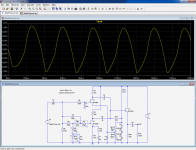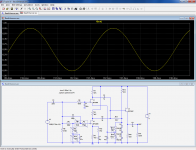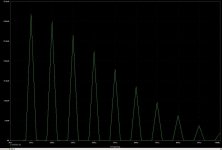The diode only lets positive going signals in, when this happens there is feedback the negative going signals go via the input and feedback resistors, in this case there is no feedback until the op amp output goes positive again.
This is about the simplest precision full wave rectifier you can make.
rcw
Very cool. Got some ballpark values?
The one function that showed the best result according to the AES articel was some exponential with an offset. From the complexity point-of-view this shouldn't be difficult to be done in analog circuitry. The enemies (as always when doing tricks with nonlinear analog circuits) are component tolarances and thermal runaway.
I will have a look at the paper again and will show a circuit that could be used but I will not do any fine-tuning etc.
The full-wave rectifier wasn't perceived as being too good in the JAES article.
Regards
Charles
Oh wow, thank you very much!
P.S.
Thermal runaway shouldn't be too bad on a little battery powered device.
No circuits, but a lot of information on the techniques and the science behind psychoacoustic processing for simulating bass from tiny speakers:
http://www.extra.research.philips.com/hera/people/aarts/RMA_papers/aar02n4.pdf
http://www.extra.research.philips.com/hera/people/aarts/RMA_papers/aar07pu2.pdf
http://www.extra.research.philips.com/hera/people/aarts/RMA_papers/aar02n4.pdf
http://www.extra.research.philips.com/hera/people/aarts/RMA_papers/aar07pu2.pdf
Here is the tube circuit converted to jFET.
First pic shows the output at 30Hz (distorted)
Second pic at 1KHz (undistorted)
All the pots are centered. Other values can be tweaked too (corner frequency of lowpass, etc).
If you want to make a virtual test, LTspice can accept a wav file as input voltage, process it and write it to an output file.
The operation will be similar to the original tube circuit (ie. pretty crude)
The nominal voltage is around 0.5Vrms
First pic shows the output at 30Hz (distorted)
Second pic at 1KHz (undistorted)
All the pots are centered. Other values can be tweaked too (corner frequency of lowpass, etc).
If you want to make a virtual test, LTspice can accept a wav file as input voltage, process it and write it to an output file.
The operation will be similar to the original tube circuit (ie. pretty crude)
The nominal voltage is around 0.5Vrms
Attachments
If you put the three resistors in the rectifier, i.e. Ri, Rf, Rl, in the ratio 2:1:3, the result is equal gain for both directions, there might be some sonic advantage in asymmetry but I am not sure.
The Philips references do report that people seemed to prefer the second harmonic only scheme such as this although in theory the third should also be present.
There might be something gained by using a simple diode limiter to give some third harmonic, it is certainly worth the experiment.
rcw
The Philips references do report that people seemed to prefer the second harmonic only scheme such as this although in theory the third should also be present.
There might be something gained by using a simple diode limiter to give some third harmonic, it is certainly worth the experiment.
rcw
Hi,
Probably the easiest way of doing this is :
Instead of a cheap, fairly nasty sounding crude analogue implementation,
create some MP3 files with the effect included with a good PC plugin.
Use the intended rock box as the PC sound monitor whilst doing this.
Whilst your at it also EQ the files and compress the dynamic range of
the bass and generally fiddle with the files to your hearts content.
Or :
You can get a chip described as a portable tone processor that boosts
and controls bass levels with a fixed 4dB treble boost, otimised it says
for portable drivers around 3". I'm pretty sure such a chip is built into
my computer speakers :
see http://www.diyaudio.com/forums/full...r-speakers-what-you-can-get-25-usd-15gbp.html
No real shenanigans here, low bass is cut-off and what harmonics
are already in the signal are boosted, driver excursion is controlled.
I don't know the exact chip used, but a search should find something.
http://www.classiccmp.org/rtellason/chipdata/ba3870.pdf
If you further search on SRS or WOW chips, something like :
NJM2195L datasheet - SRS Wow Audio Processor
can be added, but I think you'll still need the first chip.
rds, sreten.
Probably the easiest way of doing this is :
Instead of a cheap, fairly nasty sounding crude analogue implementation,
create some MP3 files with the effect included with a good PC plugin.
Use the intended rock box as the PC sound monitor whilst doing this.
Whilst your at it also EQ the files and compress the dynamic range of
the bass and generally fiddle with the files to your hearts content.
Or :
You can get a chip described as a portable tone processor that boosts
and controls bass levels with a fixed 4dB treble boost, otimised it says
for portable drivers around 3". I'm pretty sure such a chip is built into
my computer speakers :
see http://www.diyaudio.com/forums/full...r-speakers-what-you-can-get-25-usd-15gbp.html
No real shenanigans here, low bass is cut-off and what harmonics
are already in the signal are boosted, driver excursion is controlled.
I don't know the exact chip used, but a search should find something.
http://www.classiccmp.org/rtellason/chipdata/ba3870.pdf
If you further search on SRS or WOW chips, something like :
NJM2195L datasheet - SRS Wow Audio Processor
can be added, but I think you'll still need the first chip.
rds, sreten.
Last edited:
I have a portable stereo that has two 3" drivers and uses a "speaten filter" IC to boost the bass and treble. I really haven't bothered to read the datasheet for the IC, but I don't think it is doing any sort of psychoacoutstics.
I don't know whether it's just the implementation or the drivers used, but to be honest this thing sounds pretty bad. Annoyingly "boomy" and the drivers reach xmax at even moderate levels because of the bass boost.
http://www.dedekind.jp/pdf/mz01_e.pdf
I don't know whether it's just the implementation or the drivers used, but to be honest this thing sounds pretty bad. Annoyingly "boomy" and the drivers reach xmax at even moderate levels because of the bass boost.
http://www.dedekind.jp/pdf/mz01_e.pdf
In the aforementioned JAES article form November 2011 there was a list of nonlinear mathematical functions that were used to synthesise bass and which were evaluated in terms of subjective bass enhancement effect and how they affect other frequency bands with unwanted byproducts. They even found some of the functions to be "bass-killers". One function that was rather simple and that belonged to the best ones was the the following one. It could be implemented via the "classic" analog exponential function using the nonlinear properties of a transistor. If the trnasistor variant will not work it could maybe also approximated with a diode-resistor network.
The Nominator is just a scaling factor. The difference e - exp (1-x) is making the output voltage zero for an input voltage of zero. The exponent 1 - x instead of just x or - x is shifting the function. The total function is a nonliear, continuous and monotonic.
The Nominator is just a scaling factor. The difference e - exp (1-x) is making the output voltage zero for an input voltage of zero. The exponent 1 - x instead of just x or - x is shifting the function. The total function is a nonliear, continuous and monotonic.
Attachments
Thank you sir! This real circuit will make an excellent comparison point. I just love having the first Ultrabass converted to Solid State.Here is the tube circuit converted to jFET.
First pic shows the output at 30Hz (distorted) Second pic at 1KHz (undistorted) All the pots are centered. Other values can be tweaked too (corner frequency of lowpass, etc). If you want to make a virtual test, LTspice can accept a wav file as input voltage, process it and write it to an output file. The operation will be similar to the original tube circuit (ie. pretty crude) The nominal voltage is around 0.5Vrms
Yes, the one with component values looks build-able.There you have it Daniel, four schemes, I am sure you can find at least one to suit. rcw
I derived a circuit that delivers the following output spectrum when fed with 1 kHz. There is one or another cap that would have to be redimensioned when used with low frequencies.
Unfortunately it is very level-dependent. Not so much the output spectrum (i.e. the ratios between the different harmonic almost stay the same) but the ratio of input to output voltage is input level dependant.
Regards
Charles
Unfortunately it is very level-dependent. Not so much the output spectrum (i.e. the ratios between the different harmonic almost stay the same) but the ratio of input to output voltage is input level dependant.
Regards
Charles
Attachments
I tried it with a one transistor/one op-amp variant. An additional OP-AMP is used for stabilisation but it isn't satisfactory so far. The approximation with a diode-transistor network isn't that good either.
The best so far (from looking at the simulation curves, not listening tests !) was something like a pseudo antilog circuit with one op-amp and two transistors - one of them in the forward path and one in the feedback path. A simple signal dependant biasing circuit makes it work over a larger range of levels than the other ones that I have tried so far.
I will also try the classic two-transistor/two op-amp antilog variant because it seems to be the only one that can be really made to work in practice. But to be useful one would have to use a pair of transistors that are tightly coupled from a thermal point of view.
Regards
Charles
The best so far (from looking at the simulation curves, not listening tests !) was something like a pseudo antilog circuit with one op-amp and two transistors - one of them in the forward path and one in the feedback path. A simple signal dependant biasing circuit makes it work over a larger range of levels than the other ones that I have tried so far.
I will also try the classic two-transistor/two op-amp antilog variant because it seems to be the only one that can be really made to work in practice. But to be useful one would have to use a pair of transistors that are tightly coupled from a thermal point of view.
Regards
Charles
Yes, it would be very interesting to have a device that matches up with that research paper.The best so far (from looking at the simulation curves, not listening tests !) was something like a pseudo antilog circuit with one op-amp and two transistors - one of them in the forward path and one in the feedback path. A simple signal dependent biasing circuit makes it work over a larger range of levels than the other ones that I have tried so far.
I will also try the classic two-transistor/two op-amp antilog variant because it seems to be the only one that can be really made to work in practice. But to be useful one would have to use a pair of transistors that are tightly coupled from a thermal point of view.
Regards
Charles
The prospect seems very useful for several applications:
The majority of full range, even the biggest full range have very limited x-max.
Very low power amplifiers have limited potential for replaying large fundamentals.
Compact speakers are plagued with bass distortion for the same reason that Steinway doesn't make pianos the size of toasters.
(and a portable application usually has all 3 caveats, plus boomy tuning for the only impact it could do)
In all of the above cases, rolling off the fundamental in exchange for psychoacoustic bass processing could decrease audible distortion. In the case of removing a terrible noise in exchange for something more favorable, having a selectable frequency response will have the largest effect on listening tests.
- Status
- This old topic is closed. If you want to reopen this topic, contact a moderator using the "Report Post" button.
- Home
- Source & Line
- Analog Line Level
- Ultrabass, psychoacoutstic low bass for little speakers




